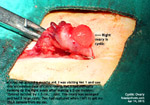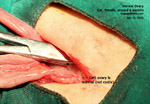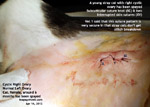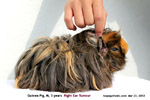The cat had been pregnant and therefore the uterine horn was not easily hooked out. There seemed to be something stuck to the left ovary as she could not pull it out. I saw large veins from the uterine body to the ovary. "I have to refer to Vet 1", she said. Complicated surgical and medical cases are farmed out to Vet 1, as this is the policy.
"Just extend the skin incision by 1 to 2 cm more," I advised. "You will see what's been affecting the ovary." She used the scissors and cut further. It was a huge surprise. Around 3 big ovarian cysts of around 1 cm in diameter. had prevented the pulling out of the ovary till the incision was extended.
"I need to take a picture," I said as this type of medical condition is very rare. She had not seen it too despite many years of spaying stray cats. She said OK and I rushed to the car park to get my camera. When I returned, she had taken out the ovary but the cyst had ruptured. There was one cyst I managed to photograph for vet students to appreciate. We are taught about ovarian cysts but in the real world, they are uncommon. "Take another picture of the normal ovary to compare," she said as I had not thought of it. I got a few tips from her.
HOW TO ENSURE THAT SPAYED STRAY CATS DON'T GET STITCH BREAKDOWN
1. Suture muscle layer and linea alba with cat gut.
2. Subcutaneous suture, interrupted, at either ends of the fatty tissue with monofilament
3. Subcutaneous suture of the fatty tissues with continuous
4. Two simple interrupted sutures of the skin, with one interrupted suture knot stitching out at one end. I can't figure this out as it is supposed to be buried.
No complaints of stitch breakdown with this method. The other knot at the other end was buried.
I just do Steps 1 and 4 in all cats and have no
problems with stitch breakdown. Too many layers (Step 2) irritate
the cat and dog during healing and also likely introduce pathogens.
Keep spay simple is my policy.
Each vet has his own tested method and will not change his or her
mindset when the method is successful. The important thing is the
client's perception as many Singaporean clients appreciate excellent
stitching (which may be a buried subcuticular suture, continuous
i.e. Step 2 without Step 3.)
VETERINARY ANAESTHESIA FOR STRAY CATS IN THIS PRACTICE
Well tested and proven to be effective and does not involve
"ketamine."
I saw two cats well anaesthesized with this procedure. The dosage is
as follows:
Spay
3kg young
Zoletil 100. 0.2ml. IM. Separate syringe.
Xylazine 20. 0.2ml. IM. Separate syringe.
duration >25min
Hartmann SC post op
DOG
Eg Jack Russell
Xylazine 20 0.3 ml first.
Zoletil 100 O.3 ml. Slow IV
To effect
Each vet has his or her own method. This method works very well and
the vet sees no need to change. For me, in cats, I give a
one-syringe Xylazine + ketamine combination IM. So, the cat gets
one injection IM instead of 2.
The less the better for our patients as injections may cause
irritation. It is hard to change mindsets of most vets when they are
used to a successful method of anaesthesia. Younger vets want to
introduce Propofol and althesin but these are expensive and add to
the inventory.
It is best that young vets be flexible and adopt what is effective
and available in the practice unless their method is more superior.
For example, diazepam and xylazine is said to be safer than domitor
and xylazine IV but I am used to the latter and find it effective.
Diazepam is said to be safer than domitor in anaesthesia by not
"affecting blood pressure or cardiac rate" according to one vet I
spoke to. Ketamine is synergistic to domitor and has been very
effective and efficient in my practice. So my younger vets have to
adapt to the practice methods first.
But how much safer is diazepam and xylazine in practice and is there
any real significant effects since domitor and xylazine are used for
short surgeries like neuter and spay? I doubt there is any
significance. How about xylazine + zoletil instead? Zoletil is said
to be a very safe drug. There is no end to research but I do use
Zoletil in very high risk cats like the pyometra case I had written
earlier.
So, I don't also go for another type as I find my present formula
very effective and safe. In other words, there are many injectable
anaesthestics and the vet must focus on one combination.
Preferably one injection in one syringe rather than 2 injections
in 2 syringes as less injection site is better for the cat or pet or
people.
 TOA
PAYOH VETS
TOA
PAYOH VETS




